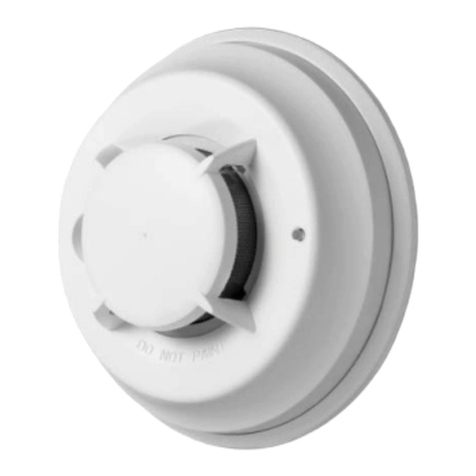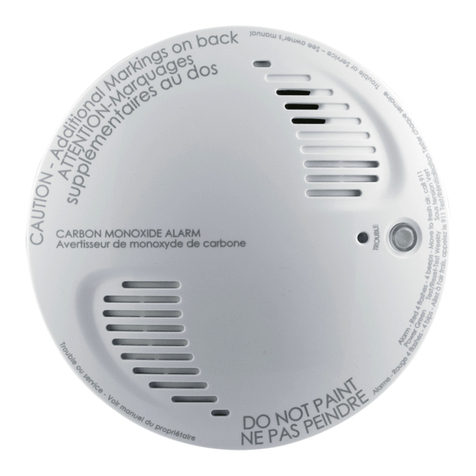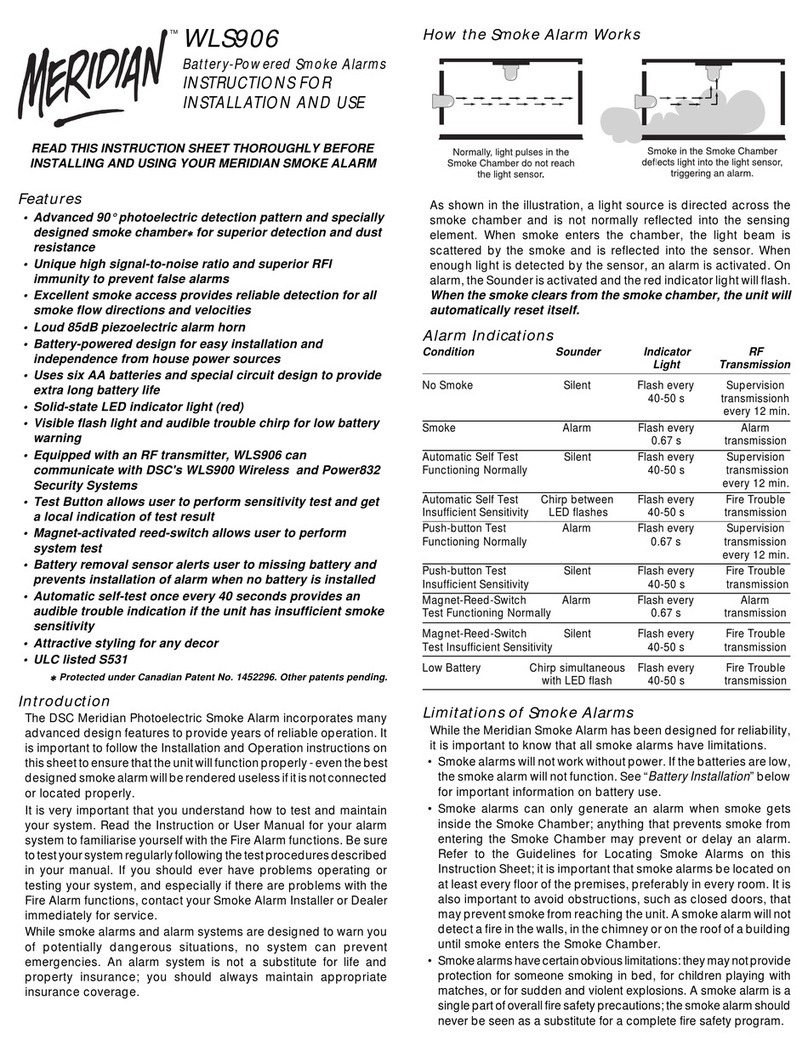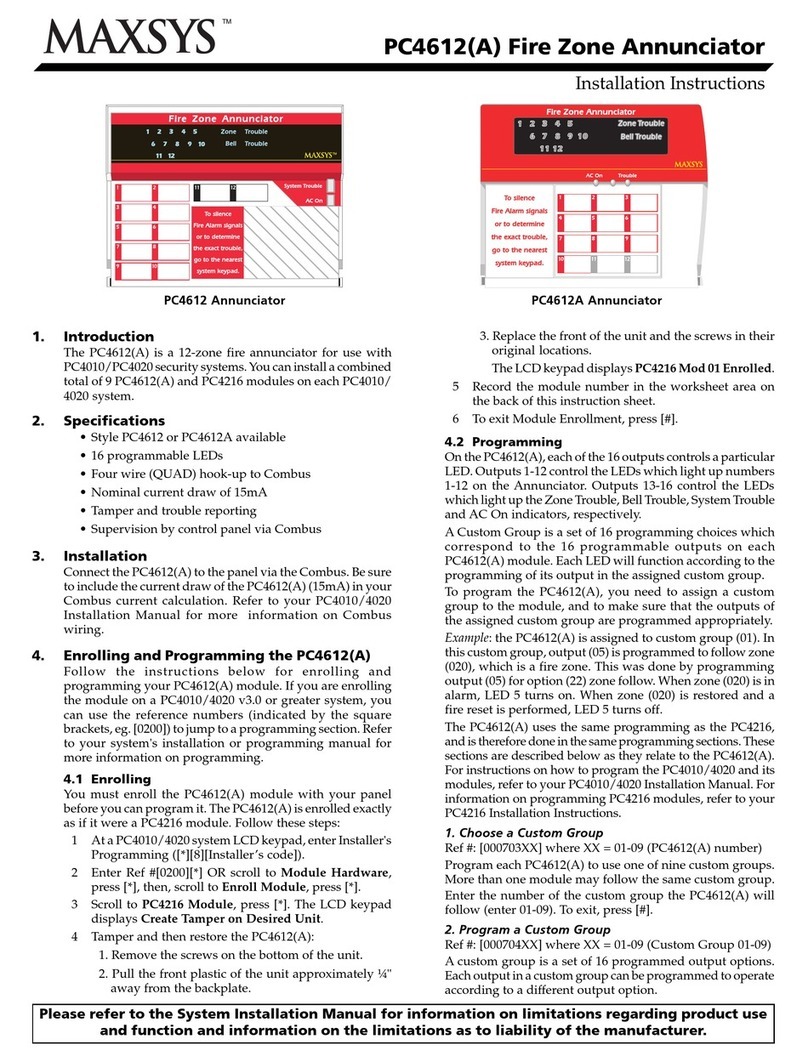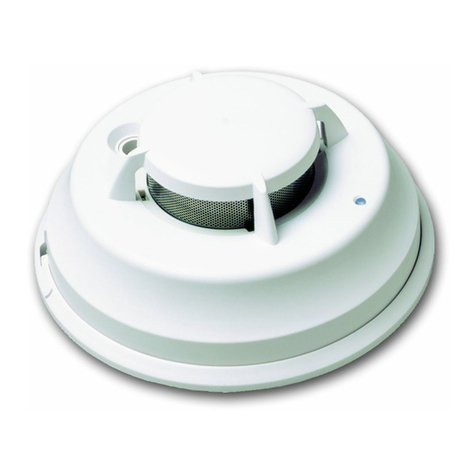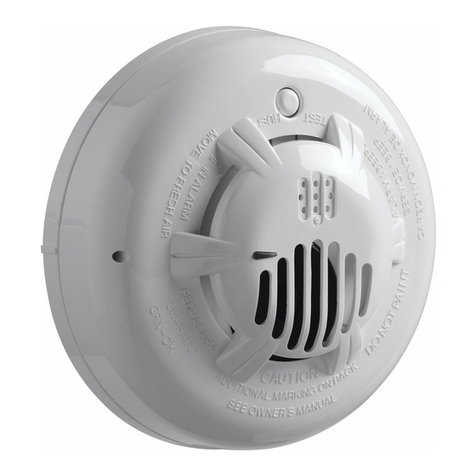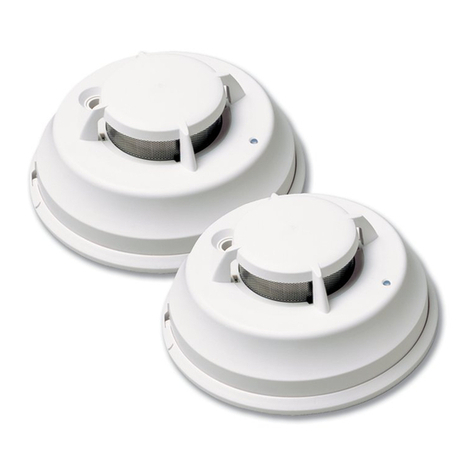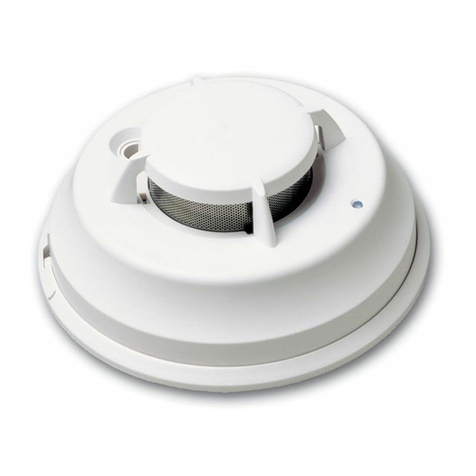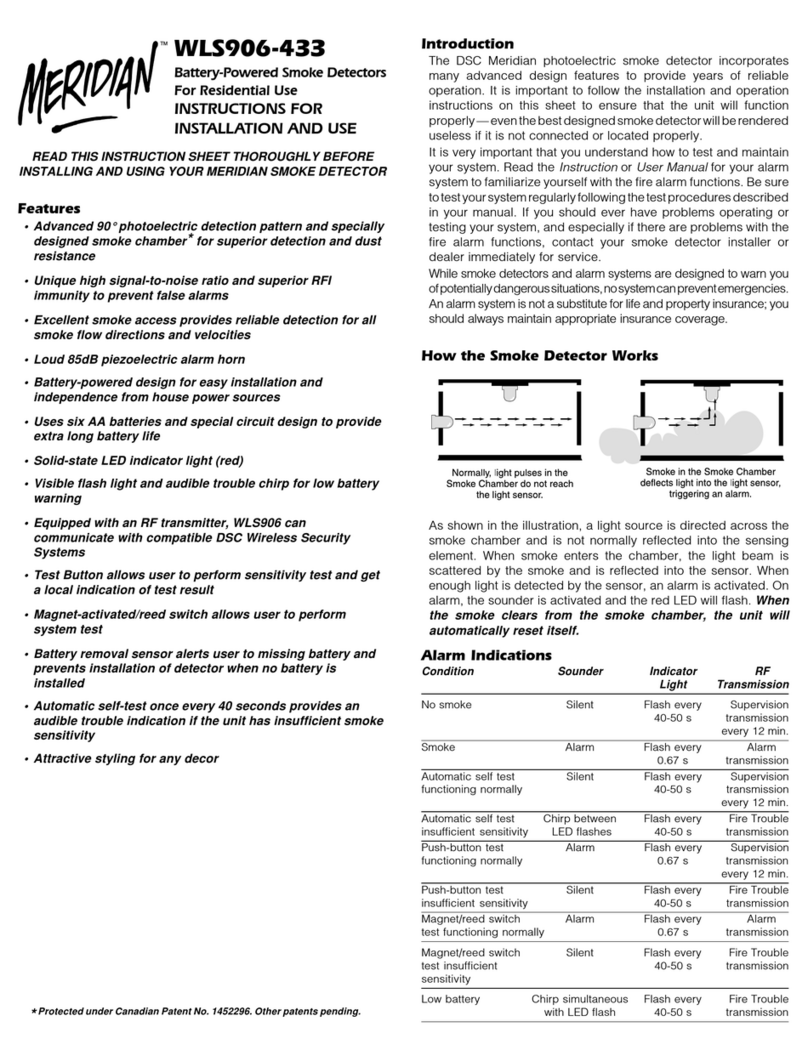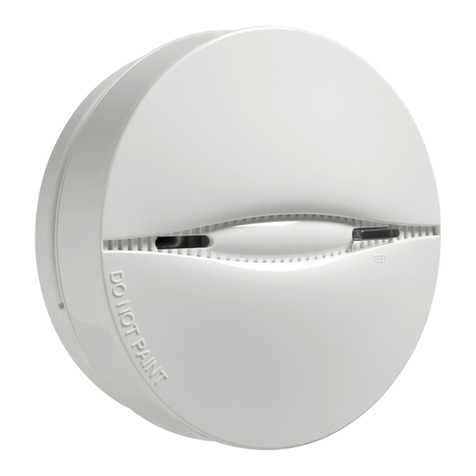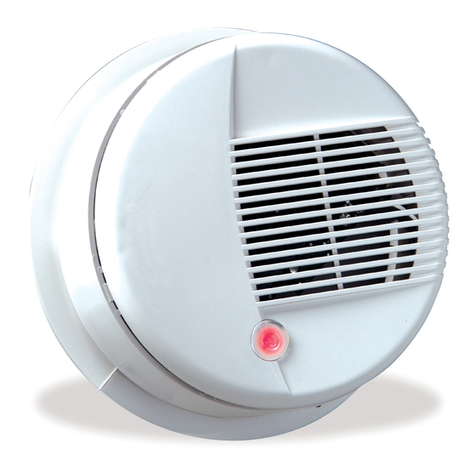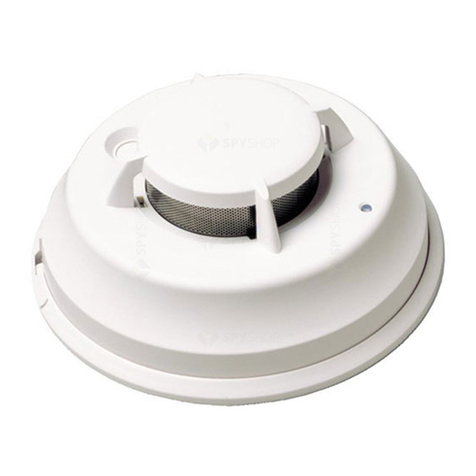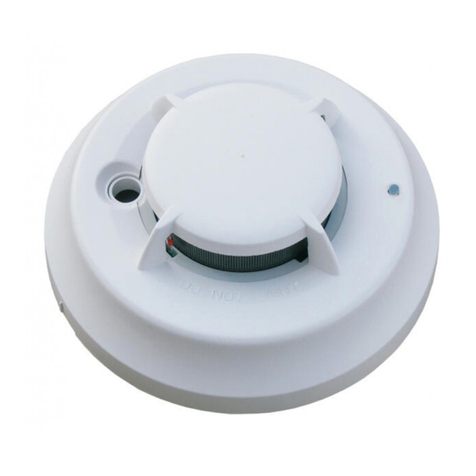29001694 R2
For Information and Technical Assistance:
© 1997 Digital Security Controls Ltd.
1645 Flint Road, Downsview, Ontario, Canada M3J 2J6
Phone: (416) 665-8460 • Fax: (416) 665-7498
Iftheunitislocatedin anarea whereitisexposedtohighlevelsofdust
or insects and is found to cause false alarms, it may require service;
contact your Smoke Detector Installer or Dealer.
Fire Safety In The Home
Most fires occur in the home, and to minimize this danger, it is
recommended that a household fire safety audit be conducted and
a family escape plan be developed.
Household Fire Safety Audit
1 Areallelectricalappliancesand outlets in a safe condition? Check
for frayed cords, overloaded lighting circuits, etc. If you are
uncertain about the condition of your electrical appliances or
household service, have a professional evaluation.
2 Are all flammable liquids stored safely in closed containers in a
cool,wellventilatedarea? Cleaning with flammableliquidsshould
be avoided.
3 Are hazardous materials such as matches out of the reach of
children?
4 Are furnaces and wood burning appliances properly installed,
clean and in good working order? If in doubt, have a professional
evaluation.
Family Escape Planning
There is often very little time between the detection of a fire and the
time it becomes deadly. Because of this, it is very important that a
family escape plan be developed and rehearsed.
1 Everyfamilymembershouldparticipate in developing the escape
plan.
2 Study the possible escape routes from each location within the
house. Since many fires occur at night, special attention should be
given to the escape routes from sleeping quarters.
3 It is essential that escape from a bedroom be possible without
opening the interior door. Consider the following when making
your escape plans:
• Make sure that doors and windows that open to the outside are
easily opened. Ensure that they are not painted shut, and that their
locking mechanisms operate smoothly.
• If opening the exit or using the exit is too difficult for children, the
elderly or handicapped, plans for rescue should be developed.
Thisincludesmakingsure that those whoaretoperformthe rescue
can promptly hear the fire warning signal.
• Iftheexitis above the groundlevel,anapprovedfire ladder or rope
should be provided, as well as training in its use.
• Exits on the ground level should be kept clear. Be sure to remove
snow from exterior patio doors in winter; outdoor furniture or
equipment should not block exits.
• The family should have a predetermined assembly point where
everyone can be accounted for; for example, across the street or
at a neighbour’s house.
• Once everyone is out of the house, call the Fire Department.
• A good plan emphasizes quick escape. Do not investigate first or
attempttofightthefire,anddonotattempttorescuebelongingsor
valuables as this takes up time. Once outside, do not re-enter the
house; wait for the Fire Department.
• Write the plan down and rehearse frequently so that should an
emergencyarise,everyone willknowwhat to do.Revisethe planas
conditions change; for example, when there are more or fewer
family members in the home, or if there are changes to the house.
• Make sure your fire warning system is operational by conducting
weekly tests. If you are unsure about system operation, contact
your Smoke Detector Installer or Dealer.
• It is recommended that you contact your local fire department and
requestfurtherinformationonhomefiresafetyandescapeplanning.
If available, have your local fire prevention officer conduct an in-
house fire safety inspection.
Installation Instructions
Specifications
Nominal Operating Voltage ..................... 12 - 24VDC or VFWR
Maximum Operating Voltage Range .................. 10 - 30VDC, or
10 - 26.4VFWR
Standby Current Alarm Current
@12V @24V @12 & 24V
MN240 15µA 45µA 35mA
MN240T 25µA 60µA 35mA
MN240R 15µA 45µA 60mA
MN240RT 25µA 60µA 60mA
MN240S 15µA 45µA 45mA
MN240ST 25µA 60µA 45mA
MN240SR 15µA 45µA 70mA
MN240SRT 25µA 60µA 70mA
Relay Rating (Resistive)
Form A Relay..................1A at 30VDC / 24VAC
Form C Relay .................2A at 30VDC / 24VAC
Smoke Sensitivity .........................2.5%/ft obscuration ±0.5%/ft
Operating Environment .....................0°C - 50°C (32°F - 122°F)
5% - 95% RH, non-condensing
Field Test .....................Magnet-activated switch and/or
Gemini 501 Smoke Alarm Analyser**
** Gemini Scientific, 1122B Aster Ave., Sunnyvale, CA 94086
Tel: 408-554-0310
Dimensions
Wiring
Refer to the wiring diagrams on this installation sheet and those
provided in the Installation Manual of the alarm control panel being
used with the unit.
Before connecting the unit, prepare the wires from the electrical box
for connection; the wires should not be frayed or bent.
CAUTION: If the power connections are reversed, the unit will
notoperate. Theunitisprotectedagainstdamagefromincorrect
wiring.
When wiring is completed, inspect the wiring and correct any errors
beforeapplyingpowertotheunit.Whenthewiringhasbeenthoroughly
reviewed,neatly insertthewiresintothe electricalboxandsecurethe
unit to the mounting plate.
Installer’s Maintenance Instructions
Normally,theMeridianSmoke Detector will not require maintenance.
Iftheunitismountedina high dust environment, the inlet areas of the
case may be vacuumed with a soft brush attachment.
Be sure to inform the user and their monitoring station when
maintenance of any sort is performed on the smoke detector or any
part of the alarm control system. Always test smoke detectors after
maintenance. If a smoke detector continues to generate nuisance
alarms even after vacuuming, return the unit to DSC for service.
Contact DSC at the address and number below to obtain a return
authorisation number before returning the unit.
Installer’s Responsibility to the User
It is the Installer’s responsibility to thoroughly instruct the end user of
thesystemonthe operation,testingandmaintenanceoftheirsystem.
The Installer should fully explain and demonstrate all functions of the
alarm control system and any equipment, such as smoke detectors,
connected to it. The user should be provided with all Instruction
SheetsandManualsfortheirsystemandanycomponentsconnected
to it. Complete and thorough instruction for the user is essential to
ensuretheywillobtainthegreatestbenefitfromtheirsystem. Providing
the user with complete operational information will also benefit the
Installer through a reduction in service calls for nuisance alarms.
Limited Warranty
Digital Security Controls Ltd. warrants that for a period of twelve months from the
date of purchase, the product shall be free of defects in materials and workmanship
under normal use and that in fulfilment of any breach of such warranty, Digital
Security Controls Ltd. shall, at its option, repair or replace the defective equipment
upon return of the equipment to its repair depot. This warranty applies only to defects
in parts and workmanship and not to damage incurred in shipping or handling, or
damage due to causes beyond the control of Digital Security Controls Ltd. such as
lightning, excessive voltage, mechanical shock, water damage, or damage arising out
of abuse, alteration or improper application of the equipment.
The foregoing warranty shall apply only to the original buyer, and is and shall be in
lieu of any and all other warranties, whether expressed or implied and of all other
obligations or liabilities on the part of Digital Security Controls Ltd. Digital Security
Controls Ltd. neither assumes, nor authorizes any other person purporting to act on
its behalf to modify or to change this warranty, nor to assume for it any other warranty
or liability concerning this product.
In no event shall Digital Security Controls Ltd. be liable for any direct, indirect or
consequential damages, loss of anticipated profits, loss of time or any other losses
incurred by the buyer in connection with the purchase, installation or operation or
failure of this product.
Smoke detectors that are a part of this system may not properly alert occupants of a
fire for a number of reasons, some of which follow. The smoke detectors may have
been improperly installed or positioned. Smoke may not be able to reach the smoke
detectors, such as when the fire is in a chimney, walls or roofs, or on the other side of
closed doors. Smoke detectors may not detect smoke from fires on another level of
the residence or building.
Everyfire isdifferentin theamount of smokeproduced andtherate ofburning. Smoke
detectors cannot sense all types of fires equally well. Smoke detectors may not
provide timely warning of fires caused by carelessness or safety hazards such as
smoking in bed, violent explosions, escaping gas, improper storage of flammable
materials, overloaded electrical circuits, children playing with matches or arson.
Evenif the smoke detector operates as intended, there may be circumstances when there
is insufficient warning to allow all occupants to escape in time to avoid injury or death.
Warning: Digital Security Controls Ltd. recommends that the entire system be
completely tested on a regular basis. However, despite frequent testing, and due to, but
not limited to, criminal tampering or electrical disruption, it is possible for this product
to fail to perform as expected.
Important Information: Changes or modifications not expressly approved by Digital
Security Controls Ltd. could void the user’s authority to operate this equipment.
Mounting the Unit
The Meridian Smoke Detector mounts to a standard 4" octagonal
electrical box.
12 to 24V
DC
or Full Wave Rectified power must
be supplied from a ULC-listed power supply or the auxiliary
power terminals of a ULC-listed alarm control unit. Wiring
should be in accordance with the Canadian Electrical Code,
Part I, and applicable local codes.
Remove the mounting plate from the case by pushing the locking
tab and turning the mounting plate counter-clockwise. Attach the
mounting plate to the electrical box (see diagram below for
orientation).
Smoke Detector Mounting Plate
Mounting
Holes
Locking Tab
THIS SIDE OUT
Form C Aux. Relay wires
dress through this opening
Power and Form A Relay wires
dress through this opening
4-Wire Detector System Wiring
++
-
NO
C
Models: MN240
MN240T
MN240S
MN240ST
++
-
NO
C
NC
C
NO
Models: MN240R
MN240RT
MN240SR
MN240SRT
Wiring (bottom view)
Installation Testing
When all connections are completed, apply power to the system as
describedinthecontrolpanel’sInstallationManual. Ifallconnections
are correct, there should be no alarm from any of the smoke
detectors. Ifanalarmoccurs, ensure that thereisnotanactual alarm
condition. If there is no actual alarm, remove power from the system
and check all smoke detectors for correct wiring.
If no alarm occurs, test each smoke detector by holding the test
magnet against the case near the Alarm Indicator. Refer to the
illustration in the “Testing Your Smoke Detector” section of these
instructions. When the magnet is in place, an alarm will be activated:
the Alarm Indicator Light will come ON, the Alarm Relay will be
activated,theSounder(ifequipped)willsound,andthe alarmcontrol
panel will indicate a fire alarm. When the magnet is removed, the
Sounder will be silenced and the detector will remain latched in the
alarmcondition.To resetthedetector,remove thepowersuppliedby
the alarm control panel.
